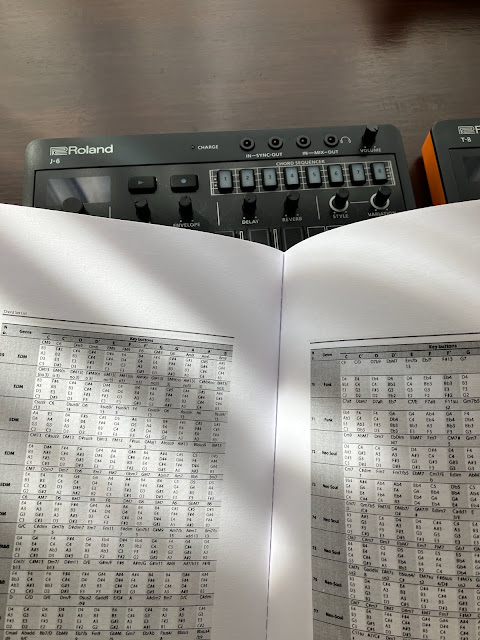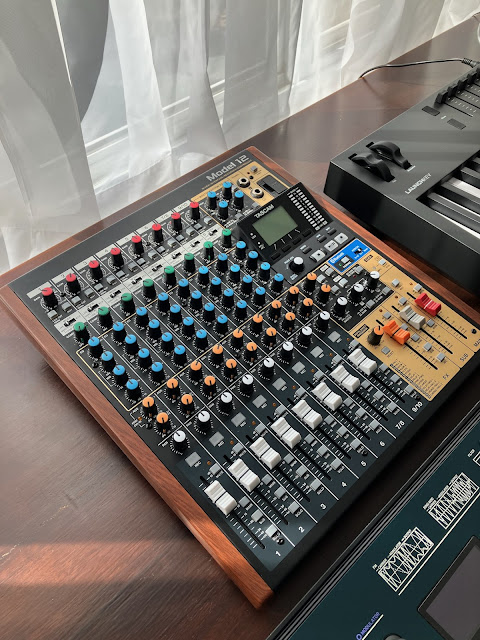Since we last left off, I discovered that the side of my room that I set up my music desk on gets kind of dark in the evening. Sadly, when this addition was built on the house, they didn't actually bother putting in any overhead lights and instead tried to make do with just a tiny bit of track lighting installed where a porch light once was.
But, it just so happened that I had a spare desk lamp kicking around, so I repurposed it here.
And speaking of additions to the desk, I'd been keeping an eye out for a good deal on a Roland Aira J-6. It's from the same line as the T-8 and S-1 pictured here, but while the T-8 is focused on drum and bass sequencing and the S-1 is focused on synth lead sequencing, the J-6 is instead built around sequencing chord accompaniments and arpeggiations.
Now I don't want to get too deep into music theory here, but my expectations for how the chord banks would be laid out, and how they are actually arranged, apparently did not align particularly well.
I don't feel like my expectations were too extravagant. I just assumed that within a given set of 12 chords I'd find that they were cohesively selected to align with a particular scale key and mode, with perhaps some creative selections where they borrow the occasional chord from related keys and modes.
And I certainly at least expected that they would be roughly arranged so that they generally rose in pitch as you ascended the keyboard.
Buuuuuuuut nope. From what I can tell there's really no theme at all to each bank of chords, and whether any pair of them makes sense tonally when played next to each other seems to be pretty much down to just luck. In fact, Roland seems to have put so little effort into the selection that they even accidentally duplicated at least one bank of chords. (For those curious, Bank 5, which they classified as "Jazz", contains a chromatic set of Major-9 chords, despite one being mislabeled as a Major-7 chord, and this is identical to Bank 21, which they classified as "Utility", which also contains the exact same chromatic set of Major-9 chords, note-for-note.)
So as a result you can either poke around the chord sets randomly (and the box gives you no visual indication of what chord it's actually playing when you hit each key) in hopes of lucking upon some combination that sounds good, or use the manual to try to reverse-engineer your way through the mess of chord banks.
However, the good news is that you can also just largely ignore the preset chord bank and just input your own chords into the sequencer by picking the notes on the built in 13-button keyboard. Somewhat annoyingly, you can't program the sequencer in step mode using an external midi keyboard. Curiously you CAN program the sequencer using an external midi keyboard when in live mode (where you play each step into the device in realtime) which is at least something I guess.
Honestly the J-6 feels like a bit of a half-baked product compared to the T-8 and S-1, though I expect I'll still get enough use out of it to justify the price (which wasn't much). If nothing else, it's a pretty neat 4-voice Juno emulator.
So, I think this lineup should keep me entertained for some time. I'll certainly be keeping an eye out for some good deals on a few other pieces of gear that I wouldn't mind adding to the setup. An upgraded drum machine might be nice, one that would get around the 32-step limitation of the T-8's sequencer, and perhaps give me more options for different drum sounds. The Roland TR-6s would fit the bill, and just to give you an idea of what it looks like, here's a photo of one:
Oh, whoops. Well, I guess it wasn't quite as hard as I thought to find one. Of course, this one was discounted for a reason, and it was a little bit rough when it showed up,
It had definitely seen a bit of cigarette smoke, plus it had been the victim of a few curious "customizations" by a previous owner, including swapping in the green knobs (which is fine, I guess), misplacing one of the fader knobs and substituting a mismatched one (I've got a matching one on the way), and adding some sort of green trim around the edge of the front panel, most of which had since chipped off.
And it was also filthy.
Luckily it's just a simple matter of popping the front cover off to disassemble and clean things.
Or at least it would have been simple if they hadn't, for some unknown reason, used an excessive amount of super glue to stick on that green trim.
But thankfully I was able to coax the top off after a great deal of struggling, without damaging any of the plastics. At least not any more than they already were.
The result after cleaning looks much nicer, though perhaps not quite perfect.
But sounding good is more important than looking good, and this drum machine sounds plenty good enough to be added to the bench.
So as I was saying, I'm not really in any hurry to add any more pieces to this setup, though I am keeping an eye open for any particularly good deals. For example, I wouldn't mind picking up a Korg Opsix synthesizer, which is an FM-based synth that has a lot of flexibility to produce tones that my Yamaha Reface CS can't do. Just to give you an idea of what one looks like, here's a photo:
Oh, whoops. I did it again, didn't I? Well, at least this one was in really good shape and didn't need any TLC to rehabilitate it.
But this does bring up a bit of an issue, in that I've got enough equipment on the bench that switching the audio back and forth is becoming a bit tedious. While the little Aira boxes have an audio pass-thru, as does my Yamaha Reface CS, neither the Opsix nor the TR-6S have that feature, meaning that I can't just chain everything into one long line to feed into the aux input on my little baby Line 6 guitar amp.
It's not really the end of the world, though, so I'm just planning to keep my eye open for a good deal on a mixer, maybe one with a built-in multi-track recorder. Something like the Tascam Model 12 would do the trick, and just to give you an idea of what one looks like, here's a photo:
Hmm, I really need to stop finding such good deals. In this case, the deal was extra sweet because the unit was malfunctioning. There's a bit of a well-known achilles heel on this model, which is that Tascam specced a really shitty power switch, and as a result the box will refuse to turn on once that $1 part suffers its inevitable premature death.
Thankfully the fix is very easy to perform for anyone who's even slightly adventurous, as I've documented here:
Ok, phew, that should be it for now. Anything else from this point on wouldn't fit on my desk, and really the only thing I could think to add might be something like a chorus effect pedal. The chorus effect really adds a lot of space and depth to synthesizer sounds, but it's not always included as a built-in feature on every synthesizer. Notably, the J-6 box doesn't include it, despite the original Juno synth that it's based on having one of the most widely celebrated chorus effects. So I'll be keeping an eye out for a deal on something like a Boss Dimension C DC-2w, which would probably fit the bill, and it even comes in a lovely purple colour as you can see here:
Well shoot, how does this keep happening?
Anyway, this chorus effect pedal takes a relatively flat sounding mono (or stereo, as of the Waza Craft edition which I have here) signal and applies a sort of phase-modulated delay to it that really livens up the sound, and in particular it gives it a ton of stereo separation.
Of course, to really take advantage of that stereo separation I'd need something other than my mono Line-6 guitar amp to output the final mix. So, I'll be keeping an eye out for a good deal on a pair of powered studio monitors, like a set of Yamaha HS5 speakers, which look roughly like this:
Hmm, damn. Well, I guess that wasn't going to keep working forever. Oh well, let's just have a good look at the setup so far.
Ah, so beautiful and clean... and also nothing's actually connected to anything else, so sadly we must summon the rat nest.
Well, that's not nearly as pretty but at least I can hear what I'm playing, which I suppose is the important part.
















No comments:
Post a Comment